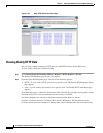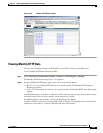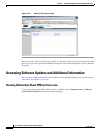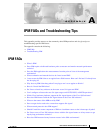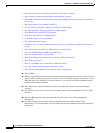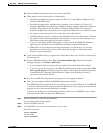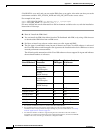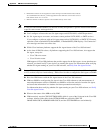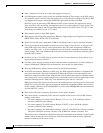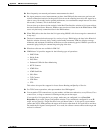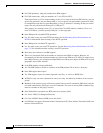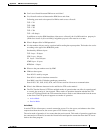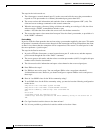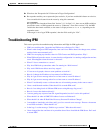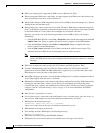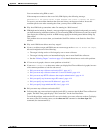
A-6
User Guide for Internetwork Performance Monitor
OL-11291-01
Appendix A IPM FAQs and Troubleshooting Tips
IPM FAQs
Q.
Does a target device need to be a router that supports SA Agent?
A.
No. IPM supports targets as long as they are reachable through IP. These targets can be Web servers,
PCs, printers, routers, switches, other network devices, or any other device with an IP address. IPM
also supports SNA targets running the NSPECHO application provided with IPM.
However, if you are measuring UDP, Enhanced UDP, or Jitter statistics for applications such as
Voice over IP or VPN monitoring, the target must be a Cisco router running a release of the Cisco
IOS software that supports the SA Agent Responder feature (Cisco IOS version 12.1(2)T or later;
we strongly recommend version 12.1 or later).
Q.
What network protocols does IPM support?
A.
IPM supports both IP and SNA monitoring. IPM also support higher level IP protocols including
DHCP, DLSw, DNS, HTTP, FTP, TCP, and UDP.
Q.
Should I install the router component of IPM on a backbone router so that it intercepts all paths?
A.
The answer depends on the number of collectors you are using at any one time. A collector is the
entity IPM creates on a router to collect performance data. The router component of IPM uses
memory and CPU cycles, so Cisco recommends you run the router component on multiple edge
routers instead. This setup distributes the load across multiple routers and better simulates typical
network traffic patterns.
Q.
Do I have to run a Cisco IOS software release with the SA Agent feature on all my routers to get
hop-by-hop performance statistics?
A.
No. Only routers actually sourcing the network performance measurements, or routers defined as
targets for Enhanced UDP and Jitter measurements, must run the SA Agent feature.
Q.
How does IPM measure latency between routers in the SNA environment?
A.
In the SNA environment, IPM uses an SNA ping. The IPM application includes a component that
runs on the mainframe. The router component of IPM sends a block of data (the request) to the
mainframe component, which in turn responds with a block of data (the response). Both the request
and response sizes can be customized by the user so that traffic flow for various applications can be
modeled. IPM supports the “SNA ping” over dependent logical unit (LU) sessions.
IPM also measures SNA latency from a router to the mainframe over a system services control point
(SSCP)-LU session. For these types of sessions, the mainframe component of IPM is not necessary.
In this scenario, IPM uses an SNA ECHOTEST to solicit an SNA REQECHO from the mainframe
over the SSCP-LU session.
Q.
How much of the router’s memory do collectors in SA Agent consume?
A.
The router memory consumed by Echo collectors depends on the release of Cisco IOS software
running on the router:
• For routers running Cisco IOS software Release 11.2 to 11.3 or 12.0, each Echo collector
consumes 40 KB of router memory.
• For routers running Cisco IOS software Release 12.0(5)T or later, each Echo collector
consumes 18 KB of router memory.
• For routers running Cisco IOS software Release 12.2(2)T, each UDP Echo collector consumes
13K, Jitter (UDP plus) collector consumes 17K, ICMP Echo collector consumes 11K.
The router memory consumed by a Path Echo collector is dependent on the number of paths and the
number of hops in the path for each collector. Path Echo operations might consume significant
amounts of memory on the source router.



